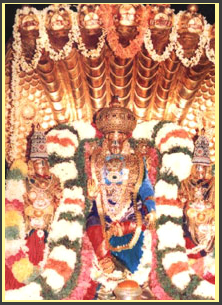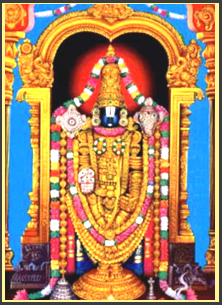 |
 |
Tirupathi - Tirumala |
| Home |
|
| History - Tirupathi - Tirumala |
|
It was during the rule of the Vijayanagar dynasty that the contributions to the temple increased. Sri Krishnadevaraya had statues of himself and his consorts installed at the portals of the temple, and these statues can be seen to this day. There is also a statue of Venkatapati Raya in the main temple. After the decline of the Vijayanagar dynasty, nobles and chieftains from all parts of the country continued to pay their homage and offer gifts to the temple. The Maratha general, Raghoji Bhonsle, visited the temple and set up a permanent endowment for the conduct of worship in the temple. He also presented valuable jewels to the Lord, including a large emerald which is still preserved in a box named after the General. Among the later rulers who have endowed large amounts are the rulers of Mysore and Gadwal. After the fall of the Hindu kingdoms, the Muslim rulers of Karnataka and then the Britishers took over, and many of the temples came under their supervisory and protective control. In 1843 AD, the East India Company divested itself of the direct management of non-Christian places of worship and native religious institutions. The administration of the shrine of Sri Venkateswara and a number of estates were then entrusted to Sri Seva Dossji of the Hatiramji Mutt at Tirumala, and the temple remained under the administration of the Mahants for nearly a century, till 1933 AD. In 1933, the Madras Legislature passed a special act, which empowered the Tirumala Tirupati Devasthanams(TTD) Committee to control and administer a fixed group of temples in the Tirumala-Tirupati area, through a Commissioner appointed by the Government of Madras. In 1951, the Act of 1933 was replaced by an enactment whereby the administration of TTD was entrusted to a Board of Trustees, and an Executive Officer was appointed by the Government . The provisions of the Act of 1951
were retained by Charitable and Religious Endowments Act, 1966. Keezh Tirupati - Govindaraja Perumal
Koil Thaayaar - Pundareegavalli. Thirumalai Theertham - Seshaasalaswami Pushkarini,
Papanasam falls, Aagaasa Gangai, Koneri Theertham Thiruchhaanur
- Alarmel Mangaapuram Theertham - Padmasarovaram. |
 |
 |
| Mangalasasanam: |
Thirumangaialwar -
988-997 Total of 12 Paasurams. |
| Special Information | |
| Dieties | Thiruvengadathan, Alarmel Mangai |
| Vimanam | Ananda Nilaya Vimanam, Seshachalam |
| Theerthangal | Swami Pushkarini, Koneri Theertham |
| Mangalasasanam | Periyazhwar, Andal, Kulasekarazhwar, Thiruppanazhwar,
Thirumazhisaiazhwar, Poigaiazhwar, Bhoothathazhwar, Peyazhwar, Nammazhwar,
Thirumangaiazhwar |
| Prathyaksham | Thondaimaan Chakravarthy, Arumugan |
| Direction and Posture | East-faced and Standing Posture |
| Travel Base | Katmandu |
| Features | The diety is known by South Indians as Srinivasa, Venkatachalapathy
and by North Indians as Balaji. There are also quite a few waterfalls
also over the Seven Hills. They are: Akash Ganga |
| Accessibility | Thirupathi is best serviced by Roadways and
Railways. And now even by airways(I don't know the exact service
details). Alight at Renigunta Railway Station on the Arakkonam(Chennai)
- Mumbai line and one can go atop the hill by buses along the ghat
road. |
| Moolavar |
| The Moolavar of this Salagrama sthalam is Sri Moorthy Perumal. He is found in Nindra thirukkolam facing his thirumugham along North direction. Prathyaksham for Brahma devan, Rudran and Kandaki. |
| How to Get There. |
Muktinath is a pilgrimage
shrine located 140 kms from Kathmandu in the snow clad Himalayas
and it is located near the Kandaki river famous for the Salagrama
stones. Muktinath is also one of the 51 Sakthi Peetams of India.
There is lots of doubt, where this Divyadesam is located. Some says
that Mukthinath, which is found 170 kms from Katmandu, it is said
the Salagrama Kshetram which is found on the banks of Kandaki river.
Mukthinath is otherwise called as "Mukthi Narayanan kshetram".
But, some say, about 65 kms away from Katmandu, there is a place by named "Damodhara Kund", which is found on the bank of Kandaki river is said to be the Salagrama sthalam. But, whatever it might be, we all the bhaktas should consider that the stones (the Salagramam) which is found on the bank of Kandaki river is said to be considered as the Salagrama sthalam. |
 There
is ample literary and epigraphic testimony to the antiquity of the
temple of Lord Sri Venkateswara.
There
is ample literary and epigraphic testimony to the antiquity of the
temple of Lord Sri Venkateswara.